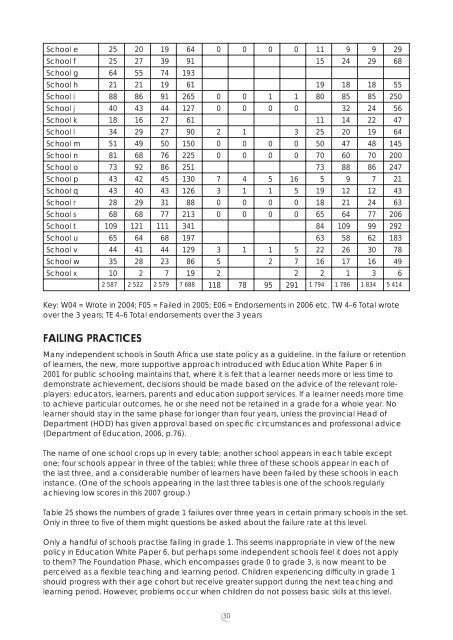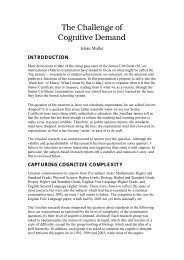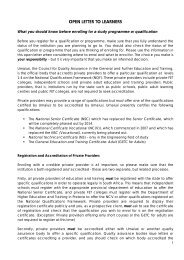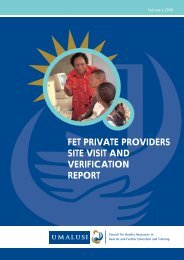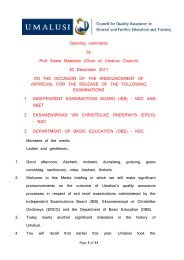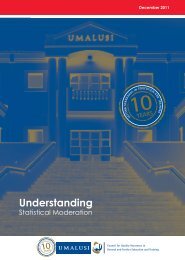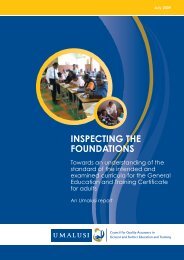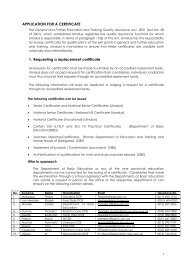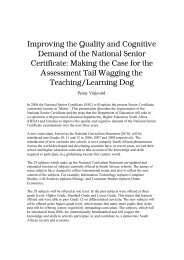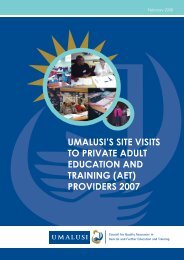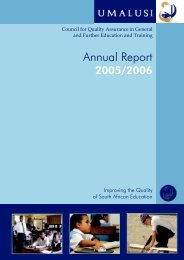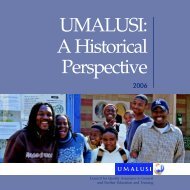UMALUSI'S SITE VISITS TO INDEPENDENT SCHOOLS IN 2007
UMALUSI'S SITE VISITS TO INDEPENDENT SCHOOLS IN 2007
UMALUSI'S SITE VISITS TO INDEPENDENT SCHOOLS IN 2007
- No tags were found...
You also want an ePaper? Increase the reach of your titles
YUMPU automatically turns print PDFs into web optimized ePapers that Google loves.
School e 25 20 19 64 0 0 0 0 11 9 9 29School f 25 27 39 91 15 24 29 68School g 64 55 74 193School h 21 21 19 61 19 18 18 55School i 88 86 91 265 0 0 1 1 80 85 85 250School j 40 43 44 127 0 0 0 0 32 24 56School k 18 16 27 61 11 14 22 47School l 34 29 27 90 2 1 3 25 20 19 64School m 51 49 50 150 0 0 0 0 50 47 48 145School n 81 68 76 225 0 0 0 0 70 60 70 200School o 73 92 86 251 73 88 86 247School p 43 42 45 130 7 4 5 16 5 9 7 21School q 43 40 43 126 3 1 1 5 19 12 12 43School r 28 29 31 88 0 0 0 0 18 21 24 63School s 68 68 77 213 0 0 0 0 65 64 77 206School t 109 121 111 341 84 109 99 292School u 65 64 68 197 63 58 62 183School v 44 41 44 129 3 1 1 5 22 26 30 78School w 35 28 23 86 5 2 7 16 17 16 49School x 10 2 7 19 2 2 2 1 3 62 587 2 522 2 579 7 688 118 78 95 291 1 794 1 786 1 834 5 414Key: W04 = Wrote in 2004; F05 = Failed in 2005; E06 = Endorsements in 2006 etc. TW 4–6 Total wroteover the 3 years; TE 4–6 Total endorsements over the 3 yearsFAIL<strong>IN</strong>G PRACTICESMany independent schools in South Africa use state policy as a guideline. In the failure or retentionof learners, the new, more supportive approach introduced with Education White Paper 6 in2001 for public schooling maintains that, where it is felt that a learner needs more or less time todemonstrate achievement, decisions should be made based on the advice of the relevant roleplayers:educators, learners, parents and education support services. If a learner needs more timeto achieve particular outcomes, he or she need not be retained in a grade for a whole year. Nolearner should stay in the same phase for longer than four years, unless the provincial Head ofDepartment (HOD) has given approval based on specifi c circumstances and professional advice(Department of Education, 2006, p.76).The name of one school crops up in every table; another school appears in each table exceptone; four schools appear in three of the tables; while three of these schools appear in each ofthe last three, and a considerable number of learners have been failed by these schools in eachinstance. (One of the schools appearing in the last three tables is one of the schools regularlyachieving low scores in this <strong>2007</strong> group.)Table 25 shows the numbers of grade 1 failures over three years in certain primary schools in the set.Only in three to fi ve of them might questions be asked about the failure rate at this level.Only a handful of schools practise failing in grade 1. This seems inappropriate in view of the newpolicy in Education White Paper 6, but perhaps some independent schools feel it does not applyto them? The Foundation Phase, which encompasses grade 0 to grade 3, is now meant to beperceived as a fl exible teaching and learning period. Children experiencing diffi culty in grade 1should progress with their age cohort but receive greater support during the next teaching andlearning period. However, problems occur when children do not possess basic skills at this level.30


